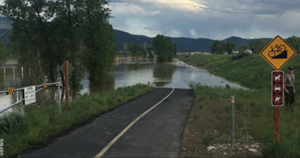 Over the past several weeks, a unique situation was unfolding along our Mountain Bluebird Nestbox Monitoring Trail here in Jackson Hole. Thanks to a serious winter, flooding occurred in our area from fast melting, high altitude snow. Historic flood levels not witnessed in decades. On a Mountain Bluebird trail of 110 nestboxes, several north of town were underwater for weeks, but fortunately those boxes were empty. However, one box — Box #4 — managed to stay just above the flood waters and it held four baby chicks inside. As the Gros Ventre River continued to flow fast and furiously, these hatchlings grew older and days closer to fledging their nest. This posed a great conundrum for the staff of JHWF… .
Over the past several weeks, a unique situation was unfolding along our Mountain Bluebird Nestbox Monitoring Trail here in Jackson Hole. Thanks to a serious winter, flooding occurred in our area from fast melting, high altitude snow. Historic flood levels not witnessed in decades. On a Mountain Bluebird trail of 110 nestboxes, several north of town were underwater for weeks, but fortunately those boxes were empty. However, one box — Box #4 — managed to stay just above the flood waters and it held four baby chicks inside. As the Gros Ventre River continued to flow fast and furiously, these hatchlings grew older and days closer to fledging their nest. This posed a great conundrum for the staff of JHWF… .
If the chicks were to fledge into water they would inevitably die. We wondered if anyone had had success with moving a nestbox with chicks inside? We thought about trying to move the box down 75 yards south to dry land. These hatchlings would still need tending to by parents so our hope would be that disturbance wouldn’t cause them to abandon their chicks if the nestbox was moved to a nearby location. Our other option was to let nature take its course; although that felt a bit tough since we’re accountable for installing an artificial nesting cavity. JHWF’s nestbox monitoring project is supporting breeding success as a mitigation effort for habitat loss throughout the Mountain Bluebirds’ range. With only good intentions in mind, either decision we made, came bearing a level of responsibility. In thinking that we could give the chicks in Box #4 a fighting chance to survive, we set about on a relocation mission.
In recent days flood waters have receded! We’ve taken HUGE sighs of relief because our attempt to move the nestbox was unsuccessful due to tricky conditions navigating through water and muck. Three days ago, one of our volunteers saw two “unbanded” fledglings just south of Box #5. These birds must be from Box #4 because all other chicks on our Trail have been banded as part of the larger research project. An adult with food was also onsite yesterday. We choose to assume that the other two chicks also fledged to dry ground. When they finally fledge the nest, Mountain Bluebird chicks have all their flight feathers and it’s possible for them to fly at least 100 yards to start. Although, it’s well documented that they choose to drop to the ground first and stay there for a while. Somehow these chicks figured out that they needed to get distance on those wings right away. Fly on little bluebirds, fly on!

Photo: US Fish & Wildlife Service
